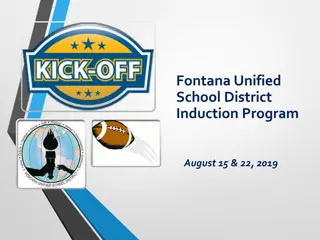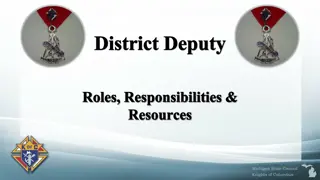Effective Practices for Singleton Teachers in Granite School District
Practical strategies and essential questions for PLCs with singleton teachers, emphasizing student-centered goals, expertise sharing, and setting team goals for student success. Learn how to navigate unique challenges and optimize collaboration in PLC meetings. Discover the human side of leading people in small school settings through the recommended book by Hansen.
Download Presentation

Please find below an Image/Link to download the presentation.
The content on the website is provided AS IS for your information and personal use only. It may not be sold, licensed, or shared on other websites without obtaining consent from the author.If you encounter any issues during the download, it is possible that the publisher has removed the file from their server.
You are allowed to download the files provided on this website for personal or commercial use, subject to the condition that they are used lawfully. All files are the property of their respective owners.
The content on the website is provided AS IS for your information and personal use only. It may not be sold, licensed, or shared on other websites without obtaining consent from the author.
E N D
Presentation Transcript
PLC Methods for Singleton Teachers For Granite School District Educators 15 - 1 Title PLC Methods for Singleton Teachers.mp3 Source and Recommended Book: Hansen, Aaron. (2018) How to Develop PLCs for Singletons and Small Schools: The Human Side of Leading People, Protocols and Practices. ASCD.
PLC Essential Questions for Singleton Teachers What do we expect our students to be able to do? (Goals/Standards) How will we know they are able to do it? (Assessment) How will we respond when they can t do it? (Intervention) How will we respond if they can already to it? (Extensions) 15-2 PLC Questions for Singleton Teachers.mp3
Square Peg? Round Hole? PLC meetings with singleton teachers can often feel like we are square pegs trying to fit into a round hole. 15-3 Square Peg Round Hole.mp3
Purpose of Singleton PLCs Yes, we ARE different - PLCs made up of singleton teachers can and should run differently than a group of teachers who teach the same content. Find Common Student-Centered Goals - PLC groups of singleton teachers, rather than common planning and analyzing student data based on curriculum standards, can and should plan PLCs based on common goals based on student achievement and performance. Access One Another s Expertise - Because we all teach different content areas and have different strengths, we can help, support and advise one another in myriad ways. We want to utilize our team members to support and improve our own practice in order to continually improve our instruction. 15-4 Purpose of Singleton PLCs.mp3
None of us is as smart as all of us. Ken Blanchard 15-5 None of us is as smart as all of us.mp3
Steps for Setting a Team Goal 1) Brainstorm essential skills students need to learn or accomplish - What are your priority standards or skills? 2) Compare essential skills to determine common ground - Which priority standards do you have in common? And with whom do you have them in common? 3) Through consensus, determine which of these common skills are most enduring or important to students future success - Which of these common standards are the most essential for ALL of our students? 4) Establish a team PEERS goal - Based on our essential skills for ALL students, what common goal do we want our students to accomplish? 15-6 Steps for Setting a Team Goal.mp3
Step 1 -Prioritize Standards Individually What are your individual priority standards? Each teacher looks at their own content standards to identify and prioritize essential life skills students should learn in their specific content. Which skills in your class are essential for ALL students to leave having mastered? 15-7 Priortize Standards Individually.mp3
Step 2 -Compare Priorities to Determine Common Ground Which priority standards and essential skills do your classes have in common? THEATRE CHORAL MUSIC INSTRUMENTAL MUSIC DANCE 15-8 Compare Priorities to Determine Common Groun.mp3
With Whom do you Have Prioritized Standards and Skills in Common? You may want to look outside your department to find teachers with whom you have common priorities. Teams may not be best determined by department, but rather teams should be determined by common priorities in student learning. VISUAL ARTS MEDIA ARTS 15-9 With Whom Do you Have Standards in Common.mp3
EXAMPLE -Classes With Common Standards on Presentation Skills FASHION DESIGN STUDIO CULINARY ARTS BIOTECHNOLOGY WORLD LANGUAGES AGRICULTURAL SCIENCE MARKETING 15-10 Example Common Presentation Skills.mp3
Step 3-Select one Common Skill on Which to Base a Goal Potential Common Priority Standards and Skills to Consider Safety Presentation skills Creating portfolios/resumes skills/Note-taking Study Conflict resolution Organization Interview skills Goal setting and management Ethics and legalities Research skills 15-11 Select One Common Skill.mp3 Creation and implementation of plans Design concepts and skills Content Literacy (Practitioner journals, manuals, etc.) Mindfulness
Step 4-Set a Team PEERS Goal Educational coaching expert Jim Knight suggests that goals that are Powerful, Easy, Emotionally Compelling, Reachable, and Student-Focused are more appropriate for educators than the format of a SMART goal, which has been commonly used in the past. 15-12 Set a team PEERS Goal.mp3
EXAMPLES -Effective PEERS Goals Set by Singleton PLC Teams ARTS EXAMPLE All arts students will effectively give, receive, and implement effective peer-to-peer feedback in order to analyze and improve their skill and performance. INDUSTRIAL ARTS EXAMPLE All Industrial Arts students will effectively understand, demonstrate, and utilize safety guidelines and practices in their work. CTE EXAMPLE All CTE students will create and present professional portfolio and interview skills to be able to communicate their work and accomplishments to a potential employer. ATHLETICS EXAMPLE All athletics students will acquire, demonstrate, and utilize skills of self-tracking and self assessing in improvement and achievement of their desired athletic ability. 15-13 Examples of PEERS Goals.mp3
Steps to Accomplish our Goals in our PLCs 5) Establish appropriate learning targets for students to develop priority skills - What will students need to be able to do or accomplish to develop this skill? 6) Determine a means for assessing student progress in learning these skills by developing common rubrics, assessments, surveys, or projects. - How will we know if our students are developing these essential skills and abilities? 7) Collect and analyze student achievement data - How are students performing at developing these skills based on our assessment data? 8) Improve our practice in teaching these skills to students - How can we improve our instruction to best teach these skills in our classrooms and at our school? 15-14 Steps to Accomplishing our Goals.mp3
Step 5 -Establish Learning Targets for Students What specific skills do students need to achieve or accomplish to develop proficiency at the standard? Layout specific and clear steps and actions for students to develop the skill. 15-15 Establish Learning Targets for Students.mp3
Step 6 -Develop Assessments of Student Proficiency and Progress Each teacher will need a way to assess their students progress and proficiency using a rubric or proficiency scale. Your team may decide to use a common means of assessment, or you may decide that you need individual assessments in your content area that have common elements with your team members, depending on your goals and team needs. Utilize Granite District proficiency scales developed for your individual content areas when creating rubrics or to assess students. 15-16 Develop Assessments of Student Proficency and Progress.mp3
Step 7 -Collect and Analyze Student Achievement Data How are students performing at developing these skills based on our assessments? After administering assessments of student proficiency, bring the completed assessments to your PLC meetings. Look at the assessments together as a team to analyze student achievement. Ask the following questions when looking at student achievement data: What are students common strengths on this skill? What are students common weaknesses on this skill? What errors are students demonstrating? What mistakes are students making? Are any students outstanding in their achievement? Are any students particularly struggling at this skill? 15-17 Collect and Anaylze Student Achievement Data.mp3
Step 8 -Improve our Practice in Teaching these How can we best teach these skills in our classrooms and at our school? Skills To improve our practice and instruction, ask the following questions as a team to assist and support one another in improving teaching practice and accessing resources when possible. What instructional or engagement strategies are working particularly well? What instructional or engagement strategies are not working? How can we acknowledge, reward, or extend? How can we differentiate or accommodate? Are there community or school partners we can utilize to teach this skill? Are there school, district, or state specialists or coaches that can support us? What documents or lessons are already made? Are there any teachers or departments outside our school that are doing this well? 15-18 Improve Our Practict in Teaching These Skills.mp3 During PLC time, make and document a plan of action moving forward to improve instruction and increase student achievement and proficiency. Follow up, report on, and improve the plan during PLCs.























